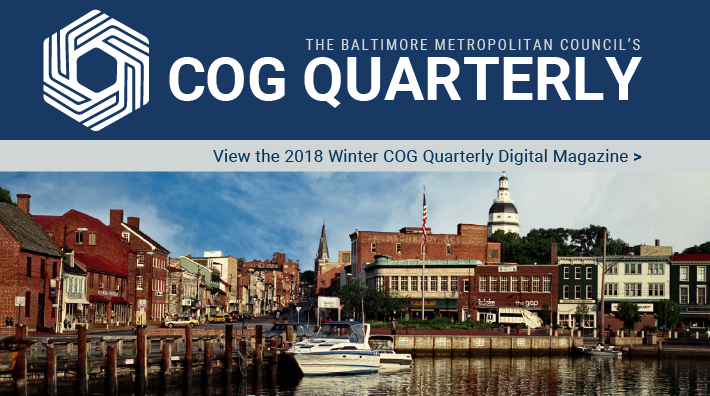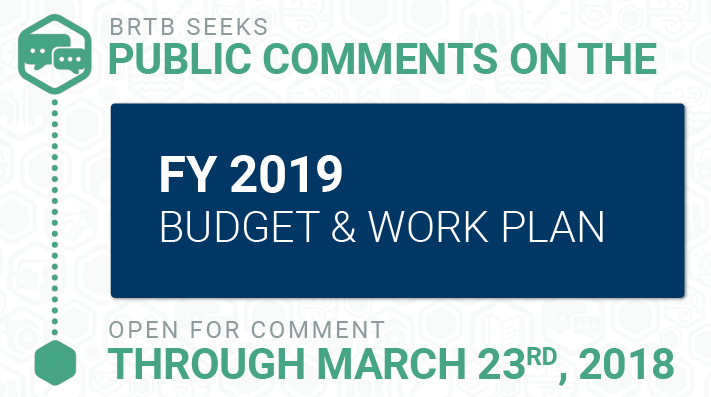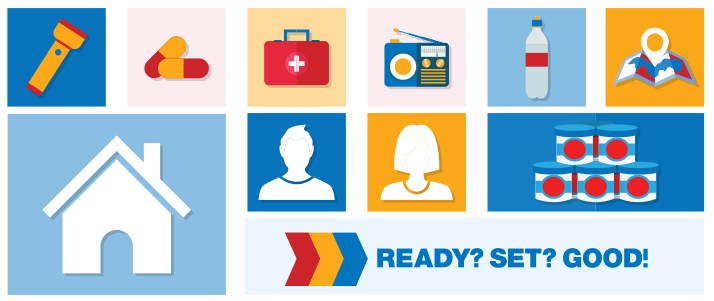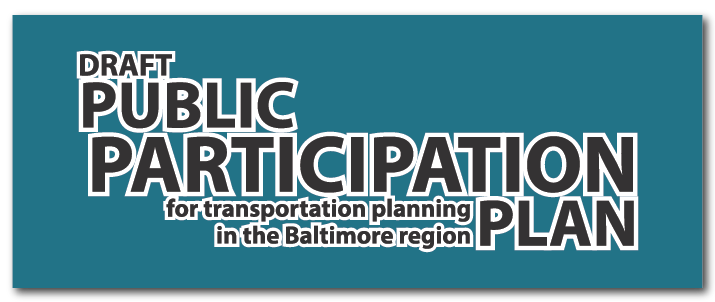
The COVID-19 pandemic has taken many by surprise as this unprecedented crisis disrupts schedules, processes, and economic activity.
Renters and the rental housing industry in the Baltimore region are no exception. While current and necessary adaptions continue such as social distancing, stay at home orders, and business and school closures, we must turn our eyes to recovery and the financial challenges that vulnerable people will face as a result of the layoffs that accompany these unprecedented public health measures.
To this end, the Baltimore Metropolitan Council’s Housing Committee – local governments, housing agencies, and other stakeholders – submitted a letter to the Maryland Department of Housing and Community Development (DHCD) on April 8 offering strong support for a robust statewide rental assistance response to the COVID-19 crisis.
The letter was signed by the Chair of the Housing Committee and of the Baltimore Regional Fair Housing Group, Erin Karpewicz from Anne Arundel County, and by the Chair of the Fair Housing Group's Public Housing Authorities (PHAs), Peter Engel from the Howard County Housing Commission.
The economic impact of COVID-19 threatens a cascade of housing-related economic hardships. Expiration of the current eviction moratorium could result in a surge of evictions even if workers return to work after a furlough but receive no back pay and therefore no ability to pay their back rent balances. Property owners missing substantial rental income risk defaulting on their loans and going out of business. Lenders left holding those bad mortgage loans and foreclosed properties could clamp down on credit, crippling the rental housing industry just as it is trying to recover from record tenant unemployment.
The submitted letter expresses strong support for a State rental assistance program to help renters, property owners, and financial institutions to bridge this public health and economic emergency. Such a program would preserve our rental housing system, helping to smooth our economic recovery from our current dramatic public health measures.
BMC looks forward to continued work with local and State housing agencies and other stakeholders in supporting solutions for the Baltimore region in response to the current crisis.

Because of the delay in the timeline for the upcoming 2020 competitive round of Low Income Housing Tax Credit (LIHTC) awards conducted by the Maryland Department of Housing and Community Development (DHCD), the Baltimore Metropolitan Council (BMC) is replacing its February 4 request for proposals for the Baltimore Regional Project-Based Voucher (PBV) Program with a new RFP (#20V07) with a revised timeline:
- Our Pre-Proposal Conference is now Thursday, March 19, 2020, 9:30 a.m. at BMC. (Rescheduled from this Thursday, February 27)
- Written questions should be sent to Dan Pontious at dpontious@baltometro.org by no later than Wednesday, April 1.
- Answers to questions will be posted on the BMC website no later than Tuesday, April 7. BMC may post answers at additional times, as well.
- The deadline for proposals is now Wednesday, April 22 by 4:00 p.m.
- We anticipate decisions by Tuesday, May 12.
The new RFP also has updated voucher payment standards for some Baltimore County census tracts. The remainder of the new RFP is identical to the February 4 RFP.
Successful applicants to this Baltimore Regional PBV Program may be eligible for scoring incentives in the upcoming competitive LIHTC round.

Stakeholders gather to discuss 'Barriers to Employment Opportunity' in the Baltimore Region and 'Scaling Workforce Programming in Baltimore' reports
BALTIMORE, MD (Monday, December, 16th, 2019) - The Baltimore Metropolitan Council (BMC) held a workforce policy briefing to announce the results of two critical research projects impacting workforce development in the Baltimore region on Monday, December 16th at 8:00AM. The event took place at BMC’s offices - 1500 Whetstone Way, Suite 300, Baltimore, MD 21230. The briefing included presentations on the Barriers to Employment Opportunity and Scaling Workforce Development Programming in Baltimore reports. Steuart Pittman, Anne Arundel County Executive and BMC board member, kicked off the morning with welcome remarks to a room of approximately 75 guests.
BMC’s Barriers to Employment Opportunity report tracks self-identified barriers to employment from job seekers in our local workforce area (Baltimore City and Anne Arundel, Baltimore, Carroll, Cecil, Harford, and Howard Counties), including current data and an analysis of how challenges have shifted over the last five years.
The report showed that some of the barriers identified were:
- Difficulties using technology and computers
- A need for new skills
- Affordability of professional clothes, transit fare, and other job-related costs
- Childcare costs
- Housing insecurity
“Barriers to employment opportunity continue to impact job seekers in the Baltimore region in complex and interconnected ways,” said Mike Kelly, Executive Director of the Baltimore Metropolitan Council. “We hope that this report helps our workforce development partners to develop programs that help jobseekers across the region find success.”
Many Workforce Development stakeholders in the Baltimore region attended the briefing to learn more about the latest barriers survey data. Many of the attendees were educators, employers and workforce development professionals dedicated to creating opportunities and solutions in the Baltimore region.
| Barriers to Employment Opportunity Report |
Linda Dworak, Director of the Baltimore Workforce Funders Collaborative, also presented an overview of the Scaling Workforce Development Programming in Baltimore report recently released by the Abell Foundation. Dworak highighted recommendations on how to achieve scale in local workforce development programming while advancing equity and without compromising quality.
The report finds that there is both labor market demand and organizational disposition for the expansion of current workforce development efforts in Baltimore City, which could put more job seekers to work. This finding prompts a call for increased funding for effective industry-sector workforce development approaches, including the expansion of local public-sector resources and investments by employers in target industry sectors. Further, the report emphasizes a focus on equity as both a process and an outcome.
“Baltimore City has many successful workforce development programs that need additional investment in order to scale,” said Dworak. “I am confident that this report and the work of the Baltimore Metropolitan Council will help us grow our proven models in order to connect more people with in-demand careers.”
| Scaling Workforce Development Programming in Baltimore Report |
Following the presentations, local workforce development experts discussed the implications of the two reports. The panel included Kirkland Murray, President CEO of Anne Arundel Workforce Development Corporation; Adrea Turner, Director of Strategic Initiatives & Senior Policy Advisor at the Greater Baltimore Committee; and Tiffani Truss, Director of Training Services at Jane Addams Resource Corporation.
###

BALTIMORE, MD (January 26, 2018) – The Baltimore Metropolitan Council (BMC) hosted a meeting of its Board of Directors on Friday, January 26, 2018 at 8:30 a.m. at the House Office Build in Annapolis. The BMC Board of Directors unanimously approved Anne Arundel County Executive Steven Schuh as its chair and Baltimore Mayor Catherine Pugh as its vice-chair for calendar year 2018.
“Our residents' lives do not stop at our county or city lines. We must remember that we are all in this together, as our strengths - and weaknesses - can be felt across the region," Schuh said. "As the incoming chair of the BMC Board of Directors, I look forward to working with my elected and appointed colleagues from each of our member jurisdictions to enhance our region's quality of life and economic vitality."
Michael Kelly, BMC executive director, said that he looks forward to working closely with Schuh throughout the year.
“County Executive Schuh is a leader whose years of experience representing Anne Arundel County will be an invaluable resource to our organization,” Kelly said. "We look forward to working with him to advance the common priorities of the Baltimore region."
###

BALTIMORE, MD (February 12, 2018) – The Baltimore Regional Transportation Board (BRTB) welcomes comments through Wednesday, March 14, on new projects and funding updates to the 2018-2021 Transportation Improvement Program (TIP) and/or Maximize2040: A Performance-Based Transportation Plan for five Maryland State Highway Administration (SHA) projects and one Maryland Transportation Authority (MDTA) project.
The BRTB is scheduled to vote on the amendments on Tuesday, March 27, at 9 a.m. The BRTB also will host public meetings on Monday, February 26; Tuesday, February 27; and Monday, March 1.
About Maximize2040 and the TIP
Maximize2040 is this region’s $12.5 billion long-range transportation plan developed by the BRTB. Maximize2040 serves as the blueprint for fiscally constrained transportation planning in the Baltimore region from the year 2020 to 2040. The plan also establishes the region’s broad transportation goals and performance measures, which now serve as guiding principles as the region plans and carries out projects.
The 2018-2021 TIP is the list of regional transportation projects requesting federal funding in the near term. It includes more than $3 billion in proposed federal, state and local money for highway, transit, bicycle and pedestrian projects during the next four years. The funding goes towards maintaining, operating and expanding the transportation system. The TIP is fiscally constrained.
Updates occur in Maximize2040 and the 2018-2021 TIP because of changes to project scope and funding or changes to federal documentation policies. Public comment periods and meetings aim to keep communication open regarding these changes.
###

Dear Friends,
When you look at the national news, it’s easy to dismiss Baltimore as a city with great challenges and struggles. But outsiders are discovering what so many of us have known about this region for years: Baltimore is a dynamic destination and it’s only getting better.
Forbes started the momentum when it dubbed us No. 14 on “America’s Coolest Cities to Live” in 2012. Then Zagat crowned Baltimore City No. 2 on “The Top 17 Food Cities of 2015.” So it’s no surprise (but still quite exciting) that we made the New York Time’s “52 Places to go in 2018,” a list of global destinations.
Our Winter 2018 COG Quarterly cover story, “Baltimore Bound,” highlights regional tourism and its intersection with transportation (Page 14). The Baltimore region has something for everyone – whether you’re a foodie or beer connoisseur, a sports fanatic or patron of the arts, nature enthusiast or leisure lover. The tourism industry is a key component of our economy, and it’s an emerging factor in how we approach transportation planning for the future.
Once again, thank you for your interest in BMC and our work.
Sincerely,
Michael B. Kelly
BMC Executive Director

BALTIMORE, MD (February 21, 2018) – The Baltimore Regional Transportation Board (BRTB) seeks public comments on its proposed updated Budget & Work Program for Fiscal Year 2019 through Friday, March 23, 2018.
The BRTB is scheduled to vote on the proposed changes on Tuesday, April 24, 2018.
The BRTB’s Budget and Work Program is known as the Unified Planning Work Program (UPWP) for Transportation Planning. It details projects, studies and other activities to be completed by BRTB members and staff of the Baltimore Metropolitan Council (BMC).
The UPWP includes both local and region-wide activities. The BRTB develops this list of regional transportation planning activities every two fiscal years. This addendum updates the funding tables for FY 2019 and identifies several new tasks.
The updated UPWP includes a total budget for FY 2019 of $7,517,700 that is funded through new allocations of federal transportation funding and projected carryover from FY 2018 to support the additional tasks as outlined below. New local and regional projects include:
- Parole Town Center Transportation Master Plan – Anne Arundel County will conduct a comprehensive assessment of the existing and future mobility needs in the Town Center area.
- Columbia Gateway Transportation Improvement Implementation Strategy – Howard County will conduct a study for the Columbia Gateway, the 8 million squared-feet complex of commercial and industrial space. The complex is an important and critical driver of economic activity in Howard and Anne Arundel counties, as well as the region. It is starting to experience additional development pressure as restrictive covenants on properties expire.
- Kent Island Cox Creek Connector Study – Residents and visitors of Kent Island continue to experience increased traffic on the island, particularly during the summer months when beach-bound vehicles increase along the US 50/301 Bay Bridge Corridor. The majority of the congestion experienced on the island is attributed to increasing traffic volumes on the Bay Bridge, although Kent Island has experienced some growth caused by new residential areas, and retail and business-development. This project is to take the concepts from the Kent Island Transportation Plan and refine them into preferred alternatives and initial design.
The BRTB also proposes adding several new focus areas for BMC staff to pursue. They include:
- Assisting local jurisdictions in preparing project information for the Chapter 30 scoring and Priority Letter submittals;
- Studying and developing guidance on how to accommodate and utilize new or emerging transportation trends and technologies. Examples include: ride-hailing, shared-mobility, electric vehicles, connected and autonomous vehicles, or combination of them to support regional and local transportation, growth, and environmental goals;
- Performing forecasted population and employment scenario analysis. Current forecasts predict shifts in labor exchange between the Baltimore and Washington regions and greater reliance on labor force markets outside of the former. This analysis will explore how changing labor market locations impact planned transportation improvements and what shifts in the local labor market could take place.
B’More Involved
The public is invited to share their thoughts on these proposed regional transportation planning activities through Friday, March 23, 2018. Please send all comments in writing to:
Email: comments@baltometro.org
Twitter: @BaltoMetroCo or @BmoreInvolved, using #BRTBlistens
Mail: The Baltimore Regional Transportation Board
1500 Whetstone Way, Suite 300
Baltimore, MD 21230
Fax: 410-732-8248
Comments may also be shared during the Public Comment Opportunity at the BRTB meetings at 9 a.m. on Tuesday, March 27, 2018, or before the vote on Tuesday, April 24, 2018.
The BRTB is the federally recognized metropolitan planning organization for transportation in the region. BMC provides the BRTB with staff support.
The BRTB operates its programs and services without regard to race, color, or national origin in accordance with Title VI of the Civil Rights Act of 1964, and other applicable laws. Appropriate services can be provided to qualified individuals with disabilities or those in need of language assistance who submit a request at least seven days prior to a meeting. Call 410-732-0500.
###

BALTIMORE, MD (April 5, 2018) – Extreme weather, power outages and other disasters happen every day around the world. Residents in the Baltimore region need to prepare at home before an emergency occurs.
“Ready? Set? Good!” is a call-to-action emergency preparedness campaign through the Baltimore Urban Area Security Initiative (UASI) that encourages people to, at minimum, put aside a portable, battery-powered radio, flashlight and one gallon of water per person, per day to help get them through those first critical hours when basic services are down. The campaign targets homeowners, heads of households, moms, dads, caregivers and families to prepare for an emergency before one happens.
The first 72 hours into an emergency are critical. It can take emergency personnel that long to restore basic services – electricity, heat, water, clearing of streets from snow and debris, etc. By preparing at home with a radio, flashlight and water, residents would:know what outside communication is available about the situation; navigate safely around the home; and stay hydrated.
“Ready? Set? Good!” also encourages residents to use a checklist to prepare other items – blankets, non-perishable foods, family plans, pet supplies, etc. Adults should keep a checklist in their wallets or purses as a reminder, and purchase items whenever they are at a store running other errands. For more information, including tips and a checklist of recommended items, visit www.readysetgood.org.
In addition, “Ready? Set? Good!” advertisements will appear on television, radio and digitally through Memorial Day weekend through partnerships with Entercom Communications and the Sinclair Broadcasting Group.
The “Ready? Set? Good!” emergency preparedness campaign is a regional effort funded by the Baltimore UASI, a preparedness grant from the federal government. UASI member jurisdictions include the City of Baltimore, the City of Annapolis, as well as Anne Arundel, Baltimore, Carroll, Harford and Howard counties. The committee also works closely with the Maryland Emergency Management Agency (MEMA).
###

BALTIMORE, MD (April 10, 2018) – The Baltimore Regional Transportation Board (BRTB) will accept comments on a draft of the Public Participation Plan through Thursday, May 24.
View the BRTB's draft Public Participation Plan
The draft of the Public Participation Plan is scheduled for a vote before the BRTB on Tuesday, June 26.
The Public Participation Plan serves as a guide for residents in the Baltimore region to navigate the public process, while also outlining the policies and procedures to ensure that those coordinating the planning process engage the public. The mission of the Public Participation Plan is to provide an open process that offers reasonable access to information, timely public notice, full public access to key decisions, and support for early and continued involvement of stakeholders.
The BRTB’s Public Advisory Committee (PAC) helped to develop the draft through its Public Involvement subcommittee.
###

Dear Friends,
The Orioles are back in town, tulips are in bloom and temperatures are again cresting the 70-degree mark. There’s no doubt that spring has sprung in the Baltimore region, which means Bike to Work Day is right around the corner.
In our COG Quarterly cover story, we’re gearing up – literally and figuratively – for Friday, May 18, when our region will celebrate its 21st year of Bike to Work Day. This annual event, encourages commuters from Baltimore and surrounding counties to swap their cars for a bicycle and enjoy a clean, healthy, affordable ride to work. The big day is coordinated each year by BMC and its member counties and generously supported by public and private sponsors. We hope that you’ll join us for this fun event. Please read about Bike to Work Day, as well as some of BMC's other activities in the Spring 2018 issue of COG Quarterly, our digital magazine.
Sincerely,
Michael B. Kelly
BMC Executive Director
